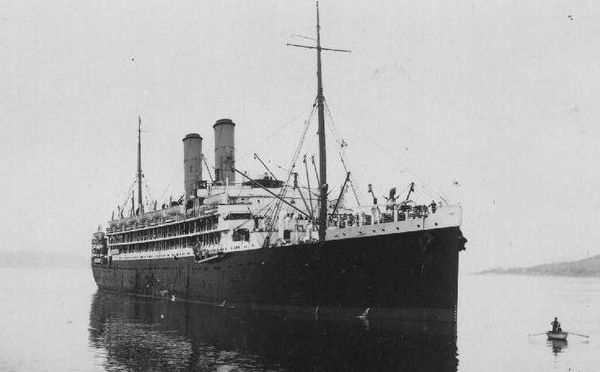RMS Ormonde
From Our Contribution
 | |
| History | |
|---|---|
| Name |
RMS Ormonde |
| Builder/Built | 1917 John Brown & Co Ltd, Clydebank |
| Type | Troopship |
| Displacement | 14,853 tons |
| Speed | 18 knots |
Contents
Remarks
On October 21, 1913 the keel of the new Orient liner was laid in Yard 425 at the John Brown & Co Ltd, shipyards at Clydebank. However, with a war imminent all work was halted in August 1914 and the un-named ship remained unfinished in the yard.
Yet due to the war being very close, there was a demand for troopships, thus early in 1917 work on the ship recommenced and she was completed with spartan quarters suitable for troops. On February 10, 1917 she was launched without a ceremony, or any fuss, and she remained un-named, and she was towed to the John Brown Fit-Out Berth where she would be completed.
Then in October 1917, she was officially requisitioned under the “Liner Requisition Scheme” as a Troop Transport ship. A month later, on November 3, 1917 the completed troopship was delivered to the Orient Line. On December 5, she was officially registered at Glasgow in the ownership of the Orient Steam Navigation Company Co. Ltd., London as Ormonde, with a tonnage of 14,853 GRT
Once the Ormonde had completed her trooping duties on June 14, 1919 she returned to John Brown’s Fit-Out berth at Clydebank where she would be completely refitted into what she was originally meant to be a fine Passenger liner! She was fitted with spacious lounges, saloons and dinning rooms and accommodations for; 278 First Class, 196 Second Class and 1,017 Third Class passengers.She also served as a troopship during WW2. And after the war made 17 voyages with emigrants to Australia.
On April 2, 1920 the Ormonde struck the bank whilst in the Suez Canal, which damaged two blades of her port propeller, yet, she was able to continue to Colombo, Ceylon at a reduced speed. Having arrived there she was dry-docked, and her propeller was rapidly changed and she continued to Fremantle, and to Sydney and Brisbane.
In Late 1952 she was retired and sold to the British Iron and Steel Corporation for scrap.
Soldiers carried
Fremantle to Port Suez 13 Mar - 4 April 1918
- Henry Joseph Carroll
- Leslie Norman Elkington
- James Richard Parry (Dick) Murray
- Wilfred (George) Nettleton
- John George (Jack) Ray
- Douglas Gordon Scott MC Post WW1 men
- Samuel Arthur Vincent
Port Tewfik to Southampton 30 Apr - 15 May 1918
- Wilfred (George) Nettleton
- John George (Jack) Ray
- Douglas Gordon Scott MC Post WW1 men
- Samuel Arthur Vincent